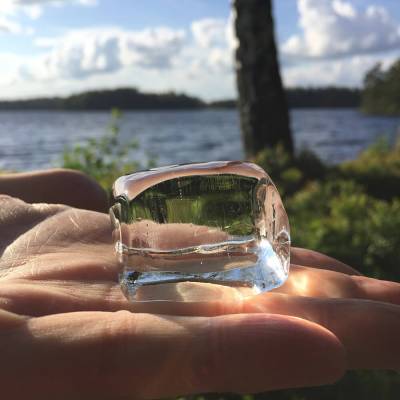One of the most important things, if your Gin and Tonic or drink should look really professional, is that the ice being used is crystal clear. Achieving this, might be easier than you think and has nothing to do with boiling, destilling or filtering water, but something completely different, which is oxygen.
Let's be completely honest - we have probably tried all methods described on the internet, and bought every isolated mold & gadget, trying to produce the most perfect ice posible at home, without buying a professional ice machine, like you find in most bars and with professionals.
But as it turned out, all of these gadgets - besides being difficult to fill and use as well as only producing small amounts of ice at a time - also just didn't produce the results we wanted. All our buyings produced clouded ice - except one, and only if we used it in the most simple way of all, and using very few requisites...
This is what you need:
Regular cold tapwater.
1 cooler - ex. Coleman's 4,7 liter cooler.
1 breadknife - preferably a little heavy and sharp.
1 meathammer or another heavy (clean) tool, to use to hit the back of the knife.
The bottom line is, that you need use a technique called "directional freezing". This sounds difficult, you might think - but no, its actually the most simple of them all.
First you need to know, what makes the ice cloudy, because its neither the chalk or impurities in the water - its the oxygen. What happens when making regular icecubes, is that the ice is freezing from all sides at the same time, and thereby capturing the oxygen inside the icecube which eventually ends up in the center of your cubes, unable to escape. Then the oxygen is being pressed together so hard by the ice, and ends up being this cloudy core, you allways see in your icecubes. And note, that the edges of all icecubes are always perfectly clear....!
So - all we need to do, is making sure the oxygen can escape, instead of being caught in the middle. And this is so simple to do - all you need to do, is fill an isolated box with water, and remove the lid to make sure it only freezes from above, and NOT the sides. And what is more perfect for this, than a cooler box?
However - most people (including your truly) do not have a freezer big enough, to hold a traditional sized cooler. And in that case, you will be happy to know, they also comes in smaller sizes. That's right - the ones we always see in american movies, right?
We have chosen, to go with the Coleman's 4,7 liter cooler, which gives a really good isolation, and with a lid easy to remove, as this should not be on the box, when in the freezer.
The rest of the process is really simple - fill the cooler up to 3/4 of the capacity, using plain tap water, and place it in your freezer without the lid. Leave it for about 24 hours (the time can vary, depending on the temperatur in your freezer), and then take it out. At this point, it will probably look like it has frozen all the way through - but it's not....!
Flip the cooler over (you might wanna do over the sink, or step outside before doing this) and work the block of ice out of the box. It will be very cold to hold, and you can put it down on a cuttingboard, when you need to take breaks once in while.
At this point, you may already have noticed, that only about 5cm from the top, have actually frozen solid, and that you have a thinner crust in the bottom, with the core still being liquid, and this is where the oxygen have been pushed - but still not crystalized, since this is still liquid water.
Next sted is to "carve" the iceblock, so that you will get the cubes in the sizes you want them. Grab your best breadknife (a heavy knife er absolutely best for this), and start poking a hole in the bottom of the block, to drain the water out. Than carve/chop away the edges, until what you are left with, is one big block approximately 5cm tall.
If your block is still rugged after the edges have been trimmed away, a nice tip is to place a big cuttingboard in your sink, and let cold water run onto it. Then place the block of ice on the board, but away from the stream of water from the tap, as this would quickly get the best of the block. Now use the fact that the water is able to run underneath the block, to kind of grind/melt the edges away, by moving the block back and forward on the board, until you have a relatively even surface on top & bottom.
Now you are ready for the last part - to carve the block, in the size of cubes you want to use, in your drink. And this part, is much eaaier than you might think...!
Aiain - use your sharpest breadknife, to cut grooves in the block, where you wish to divide it. Not so deep - just 3-4mm - but you need to make the cur all the way from one side, to the other. Let the knife rest in the groove, and give it one or two firm hits with a meathammer or something else hard and clean. This way, your block will split in a clean cut, and you now have a stick of ice, on which you can repeat the cut same thing. Do this until, you have cut up all the ice, and put all the cubes in a freezing bag and put the bag in the freezer, for when you need them.
Don't be nervous, that all your cubes will freeze up and stick to each other - they will be easy to take apart, by pressing a knife in the cracks between the cubes, when you take them out to use them.
Your cubes will NOT get clody, from getting back into the freezer - the oxygen is already squeezed out of the cubes, and will therefor not get cloudy again!
Have lots of fun - your drinks will from now on, feel much more delicious. If you want to take it even further, you could get yourself a logostamp and press your name or logo in the cubes, before serving them - but thats a whole new story to be told in a later article :)
Note; Many asks if there will be different outcomes from using tap water, bottled water or boiled and filtered water - and there will NOT. They will all produce completely clear ice, if you follow the above description, nomatter the amount of chalk in your water. If you want to use one or the other, is completely up to you - but the visual outcome, will be the same with all these waters!!
https://www.gintossen.dk/en/blog/how-to-make-clear-ice.html#sigProIdfab9c902f1







